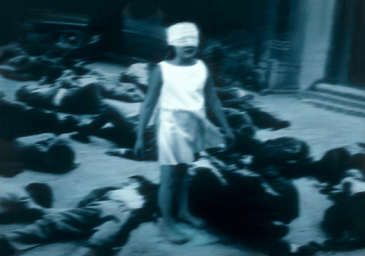Film makers and academics from around the world are joining forces for the ‘Disposable Life’ project, making a short film each month throughout 2014 and 2015 to coincide with landmark dates, such as the 100th anniversary of the outbreak of World War I in June 2014.
Experts will share their thoughts on how best to commemorate such tragic events in order to cultivate a deeper understanding of the conditions that leads to extreme violence, and in the process offering new interpretaions on the meaning and definition of violence today.
It’s part of Histories of Violence - a multimedia forum dedicated to exploring the theoretical, empirical and aesthetic dimensions to violence – established by Dr Brad Evans, from the Global Insecurities Centre at the University of Bristol.
Dr Evans, who won acclaim for the movie ‘Ten Years of Terror’ which he co-directed to mark the 10th anniversary of 9/11, said: “Mass violence is poorly understood if it simply refers to casualties on battlefields or continues to be framed through conventional notions of warfare. We need to interrogate the multiple ways in which entire populations are rendered disposable on a daily basis if we are to take seriously the meaning of global citizenship in the 21st century.”
The first video to launch the series is by celebrated feminist scholar Professor Cynthia Enloe, who explores the meaning of disposability and explores what it means to be humane in the 21st century.
Further participants will include Simon Critchley, Zygmunt Bauman, Gayatri Spivak, Henry A. Giroux, Jean Franco, Gottfried Helnwein, Saskia Sassen, Slavoj Zizek, Etienne Balibar, Griselda Pollock, Jake Chapman and Richard Sennett.
April 2014 will mark the 20th anniversary of the Rwandan genocide, when an estimated 800,000 people were massacred in just three months, which exposed to a watching global community the horrifying legacy of colonialism.
In 2015, filmmakers will confront the violence of Auschwitz; the 70th anniversaries of the bombings of Hiroshima & Nagasaki; the 65th anniversary of the start of the Korea War; and the 40th anniversary of the beginning of the Killing Fields in Cambodia, which remains one of the most violent experimental episodes in the history of human existence.
Aside from the videos, there will be a series of lectures, books and published papers covering all aspects of the project.
The ‘Disposable Life’ project is a joint initiative, funded by the following organisations:
- The Global Insecurities Centre, University of Bristol
- The Committee on Global Thought, Columbia University, New York
- The Perpetual Peace Project; The Central New York Humanities Corridor
- TAFT Research Centre, University of Cincinnati
- McMaster Centre for Scholarship in Public Interest, Ontario
- 3CT Centre for Critical and Cultural Theory, Rice University
- University California Humanities Research Institute
- The Centre for Critical Research on Race & Identity, University of Kwazulu-Natal, South Africa.
The videos can be seen on the Histories of Violence website, or follow the project on Twitter (#disposablelife), Facebook, Vimeo and YouTube.
